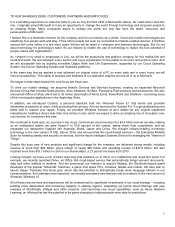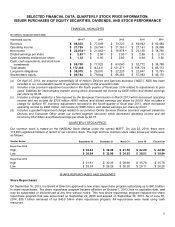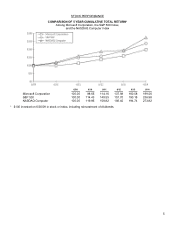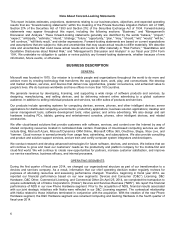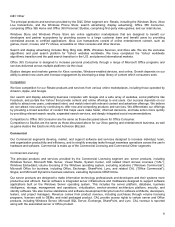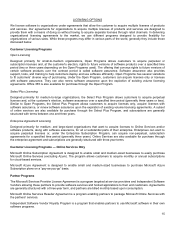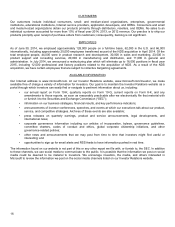Microsoft 2014 Annual Report Download - page 7
Download and view the complete annual report
Please find page 7 of the 2014 Microsoft annual report below. You can navigate through the pages in the report by either clicking on the pages listed below, or by using the keyword search tool below to find specific information within the annual report.
6
Note About Forward-Looking Statements
This report includes estimates, projections, statements relating to our business plans, objectives, and expected operating
results that are “forward-looking statements” within the meaning of the Private Securities Litigation Reform Act of 1995,
Section 27A of the Securities Act of 1933 and Section 21E of the Securities Exchange Act of 1934. Forward-looking
statements may appear throughout this report, including the following sections: “Business,” and “Management’s
Discussion and Analysis.” These forward-looking statements generally are identified by the words “believe,” “project,”
“expect,” “anticipate,” “estimate,” “intend,” “strategy,” “future,” “opportunity,” “plan,” “may,” “should,” “will,” “would,” “will be,”
“will continue,” “will likely result,” and similar expressions. Forward-looking statements are based on current expectations
and assumptions that are subject to risks and uncertainties that may cause actual results to differ materially. We describe
risks and uncertainties that could cause actual results and events to differ materially in “Risk Factors,” “Quantitative and
Qualitative Disclosures about Market Risk,” and “Management’s Discussion and Analysis” in our fiscal year 2014 Form
10-K. We undertake no obligation to update or revise publicly any forward-looking statements, whether because of new
information, future events, or otherwise.
BUSINESS DESCRIPTION
GENERAL
Microsoft was founded in 1975. Our mission is to enable people and organizations throughout the world to do more and
achieve more by creating technology that transforms the way people learn, work, play, and communicate. We develop
and market software, services, and devices that deliver new opportunities, greater convenience, and enhanced value to
people’s lives. We do business worldwide and have offices in more than 100 countries.
We generate revenue by developing, licensing, and supporting a wide range of software products and services, by
designing, manufacturing, and selling devices, and by delivering relevant online advertising to a global customer
audience. In addition to selling individual products and services, we offer suites of products and services.
Our products include operating systems for computing devices, servers, phones, and other intelligent devices; server
applications for distributed computing environments; productivity applications; business solution applications; desktop and
server management tools; software development tools; video games; and online advertising. We also design and sell
hardware including PCs, tablets, gaming and entertainment consoles, phones, other intelligent devices, and related
accessories.
We offer cloud-based solutions that provide customers with software, services, and content over the Internet by way of
shared computing resources located in centralized data centers. Examples of cloud-based computing services we offer
include Bing, Microsoft Azure, Microsoft Dynamics CRM Online, Microsoft Office 365, OneDrive, Skype, Xbox Live, and
Yammer. Cloud revenue is earned primarily from usage fees, advertising, and subscriptions. We also provide consulting
and product and solution support services, and we train and certify computer system integrators and developers.
We conduct research and develop advanced technologies for future software, devices, and services. We believe that we
will continue to grow and meet our customers’ needs as the productivity and platform company for the mobile-first and
cloud-first world. We will continue to create new opportunities for partners, increase customer satisfaction, and improve
our service excellence, business efficacy, and internal processes.
OPERATING SEGMENTS
During the first quarter of fiscal year 2014, we changed our organizational structure as part of our transformation to a
devices and services company. As a result, information that our chief operating decision maker regularly reviews for
purposes of allocating resources and assessing performance changed. Therefore, beginning in fiscal year 2014, we
reported our financial performance based on our new segments: Devices and Consumer (“D&C”) Licensing, D&C
Hardware, D&C Other, Commercial Licensing, and Commercial Other. On April 25, 2014, we completed the transaction to
acquire substantially all of Nokia Corporation’s (“Nokia”) Devices and Services Business (“NDS”). We report the financial
performance of NDS in our new Phone Hardware segment. Prior to the acquisition of NDS, financial results associated
with our joint strategic initiatives with Nokia were reflected in our D&C Licensing segment. The contractual relationship
with Nokia related to those initiatives terminated in conjunction with the acquisition. With the creation of the new Phone
Hardware segment, the D&C Hardware segment was renamed Computing and Gaming Hardware in the fourth quarter of
fiscal year 2014.


